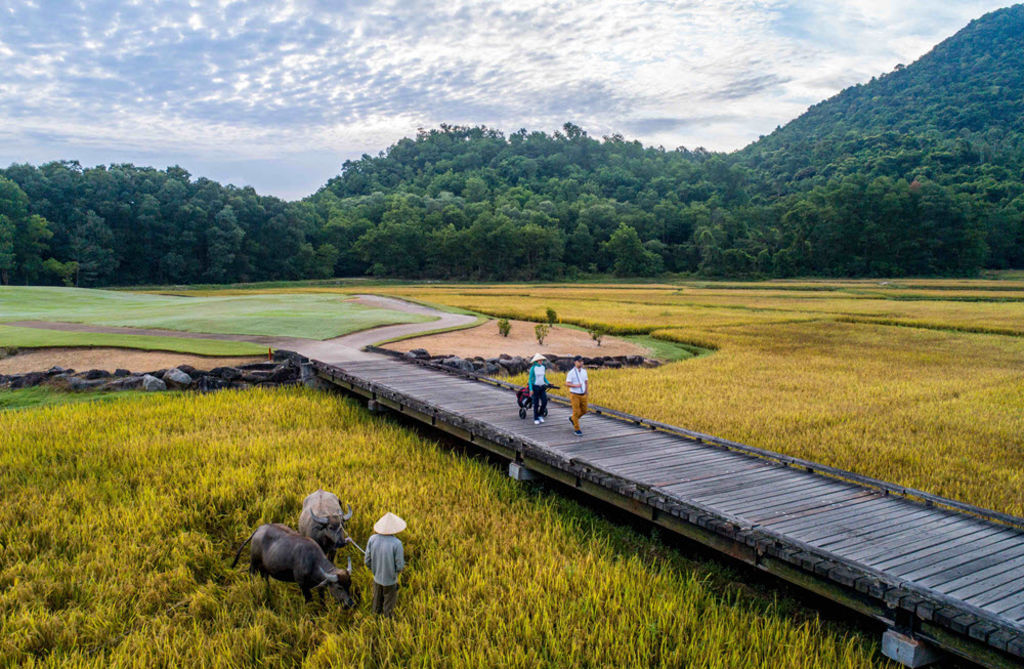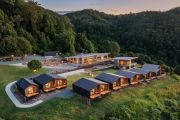
How golf clubs are using hi-tech - and a few low-tech - methods to keep their courses looking good
Golf courses are some of the most expensive commercial real estate in the world and taking care of them today involves utilising latest developments in technology – as well as relying on a few of humanity’s oldest practices.
Innovators are now experimenting with infrared cameras on drones to detect problems on courses, devising more advanced chemicals to reduce water consumption and inhibit weed growth, and even installing desalination plants.
On the decidedly low-tech side, there’s also been a rise in the number of courses using goats and sheep to keep the rough smoother, an increase in the planting of ancient grasses to withstand all types weather and even one instance of a golf course harnessing water buffalo to keep it in top shape.
“Our industry is always trying different ways to improve how we look after golf courses,” said Justin Morton, the national customer support manager of landscape management company Green Options.
“We’re always trying to be more sustainable, and more effective.”
Water buffalo have been introduced to one of Vietnam’s leading courses, the Nick Faldo-designed Laguna Golf Lang Co south of Hue, where golfers face hazards like tropical jungle, ocean sand dunes and four hectares of rice paddies.
The buffalo are frequently seen in the paddies between the third and fourth holes, and on the back nine between the 13th green and 14th tee, as well as alongside the 15th fairway, eating the excess weeds and crops.
“We are pretty sure it’s a first in this part of the world to have animals performing such an important role on the golf course,” said Adam Calver, director of golf at the club.
“We looked at various methods to increase the aesthetics of the rice paddies between the harvests as continually mowing the fields to maintain vast rice terraces can consume a large amount of labour. The water buffalo act as bio-mowers while also protecting the traditional Vietnamese landscape.”
It’s an interesting variation on the goats and sheep that are deployed in other parts of the world, most commonly in Scotland, Ireland and the US – and occasionally at home in Australia – to keep courses in tip-top condition.
In the US state of Kansas, goats are particularly favoured for eating poison ivy, and in Ohio they are used to clear hard-to-cut brush in the roughs. They’ve been put to work too as club-carrying caddies at another course in Oregon.
But the animals have created headlines for US President Donald Trump. According to a report in The Wall Street Journal he classifies his golf club in Bedminster, New Jersey, as partially ‘farmland’, and hence attracts tax exemptions, partly because a small herd of goats is kept there.
Goats have also been used in Australia, most notably at the Monarch Dunes Golf Course on the Central Coast where they tidied up the roughs when they grew a little too bushy, while sheep have been used at a couple of courses in South Australia.
“But the problem with using them here is that you have to employ a farmhand to look after livestock,” said Neil Craig, the owner of Australian Golf Course Management.
“That can be expensive and you have to fence them in at times to stop them straying onto fairways and interrupting play.”
There are even sharks at one course in Australia, Carbrook, in Brisbane, where they were washed into a lagoon in the centre of the course by a flood. That proved a great deterrent to outsiders coming in to steal balls from the water.
As well as the use of livestock as greenkeepers, it can also be back to the future in terms of grass, with old varieties being introduced to some courses in Australia. Golf course designer Mike Clayton said there was a lot of work being done looking at which grasses feel, and play, the best.
“The cool-season grass tall fescue is quite new in Australia but has been found to work pretty well,” he said. “That’s what people were playing on in Scotland in the 1800s …”
But more recent developments are increasingly being trialled, too. New grasses, such as Zoysia with a high level of salt tolerance, are being cultivated overseas and have proved especially useful for courses near the ocean, Mr Craig said.
Tough Couch grasses are also being planted to try to slow down the game that’s, ironically, sped up with new hi-tech golf clubs and balls.
Multispectral remote-sensing drones provide early warnings on the health of courses, detecting problems with pests, disease, weeds and irrigation issues before the human eye can detect them. The Australian Golf Course Superintendents Association (AGCS) is in the process of trying out a drone.
“It’s another tool you can use to find stresses on the surface,” said the association’s Brett Robinson.
“But it’s not the only new technology. Now there are GPS robotic mowers being manufactured, although they’re not in Australia yet, and some places overseas are using them.
“There are also automated and computerised irrigation systems that can be operated by a smartphone instead of the hoses we used to manually put around, and maintenance machinery has improved with reduced emissions. But the big thing is always irrigation and improved grass types that don’t need as much water.”
Hybrid mowing machines are now being developed with blades operated by solar batteries, reducing the amount of fuel they used by as much as 60 per cent, according to Justin Morton of Green Options. There are also more natural growth-regulating formulas that are more environmentally-friendly.
“You get a lot of pests on plants but now you can use tablets that the plant soaks up so the pests feeding on it die, rather than spraying an area that disperses into the air and affects everything,” he said.
“We also have wetting agents to reduce the amount of water grasses need. Experiments on sportsfields have found they reduce the water you need by around 30 per cent.”
A number of golf courses in Victoria have also installed desalination plants for their water needs. Veolia Water Technologies has helped clubs in Portsea, Barwon Heads and the Metropolitan Golf Club Victoria with their systems.
“There’s been a whole bunch of changes to maintenance of golf courses in the last few years,” said Darius Oliver of Planet Golf, a golf course consultancy.
“There’s lots of new technology as well as the re-emergence of the old. I was in Vietnam in February with the general manager of the course with water buffalo.
“They harvest the rice from the paddy fields in the middle of the golf course, so everyone benefits, and it’s a fantastic story for Vietnam, a great enterprise, and gives the course a great authentic feel.”













